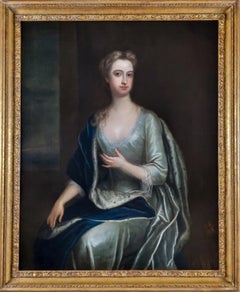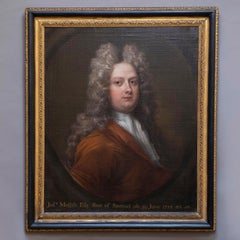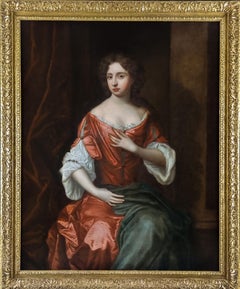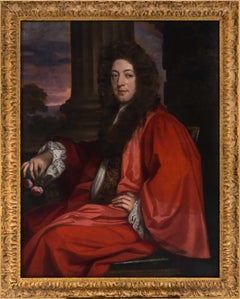Charles Jervas More Art
Irish, 1670-1739
Charles Jervas was born in Dublin in 1675 who later lived in England. After moving to England, Jervas became an apprentice to the painter Sir Godfrey Kneller. He later studied drawing in Rome and then returned (c. 1709) to England. Succeeding Kneller, he became court painter to the English kings George I and George II. His home became a centre for literary figures, among them Alexander Pope and Jonathan Swift, whose portraits Jervas painted, in addition to that of George II (1728). He produced a translation of Miguel de Cervantes’s Don Quixote (published posthumously, with his surname spelled Jarvis, in 1742).to
1
1
Overall Width
to
Overall Height
to
2
2
2
2
2
2
1
1
5
344
227
181
116
2
Artist: Charles Jervas
Portrait of Frances, Viscountess Scudamore in a Silver Dress & Blue Cloak
By Charles Jervas
Located in London, GB
Portrait of Frances, Viscountess Scudamore in a Silver Dress and Blue Cloak c.1709-1719
By Charles Jervas (1675-1739)
This elegant and graceful portrait, presented by Titan Fine Ar...
Category
18th Century Old Masters Charles Jervas More Art
Materials
Canvas, Oil
Charles Jervas, Portrait of Joseph Mellish
By Charles Jervas
Located in London, GB
Charles Jervas (1675-1739)
Portrait of Joseph Mellish (1675-1733)
Oil on canvas; held in a carved period frame
Dimensions refer to size of frame.
Provenance: Blyth Hall, Nottinghamshire, England; by descent to Sir Andrew Buchanan of Hodsock Priory, Nottinghamshire
In 1635 John Mellish, a merchant tailor of London, bought the estate of Blyth in Nottinghamshire. His son, a wealthy Oporto merchant, dying unmarried, left Blyth in 1703 to a cousin, Joseph Mellish, who became one of Newcastle’s earliest and most important political supporters in the county. He went up to Clare College, Cambridge in 1692 and on to the Inner Temple the following year. He married Dorothea Gore, daughter of Sir William Gore...
Category
Early 18th Century Old Masters Charles Jervas More Art
Materials
Oil
Related Items
Portrait of a Lady in Red Dress on Porch c.1680, English Aristocratic Provenance
Located in London, GB
Presented by Titan Fine Art, this painting formed part of a historic collection of an English aristocratic family, Lord and Lady Sandys at their magnificent baroque and Regency Grade-I listed family home, Ombersley Court. The house was among the most fascinating survivals of its kind in this country. The atmospheric interiors were distinguished above all for the works of art associated with two key moments in national history. The collection was acquired or commissioned over five centuries and remained at Ombersley Court until its recent sale, the first in 294 years. This portrait hung in the Grand Hall.
This exquisite grand manner work is an evocative example of the type of portrait in vogue during a large part of the seventeenth and eighteenth centuries. The artist has depicted an elegant lady, three quarter length and seated on porch with a luxurious crimson swag curtain by her side. The clothing – known as “undress” at the time, consists of red silk fastened at the front and sleeves by large gold and diamond jewels over a simple white chemise. In her lap she holds a blue wrap and in her other hand, at her chest, she clutches the end of a sheer gauzy scarf that has been draped around her body with the other end a type of headdress – this type of sheer scarf was often employed by Wissing in his portraits. The classical architecture signifies cultivation and sophistication and the luxurious swag curtain is a signifier of wealth. The portrait can be dated to circa 1680 based on the sitter’s attire, the “hurluberlu” hairstyle, and other portraits by Wissing using the same formula.
This oil on canvas portrait has been well cared for over its life, which spans almost 350 years. Having recently been treated to remove an obscuring discoloured varnish, the finer details and proper colour can now be fully appreciated.
Once owned by Evesham Abbey, the manor of Ombersley was acquired by the Sandys family in the early 1600s, when Sir Samuel Sandys, the eldest son of Edwin Sandys, Bishop of Worcester and later Archbishop of York, took a lease on the manor, before receiving an outright grant in 1614. The present house, Ombersley Court, dates from the time of Samuel, 1st Lord Sandys, between 1723 and 1730. The house itself is a fine example of an English Georgian country house set in rolling countryside and surrounded by Wellingtonias, planted to commemorate the Battle of Waterloo by Arthur Hill, 2nd Baron Sandys, who played a distinguished part in the battle and was one of the Duke of Wellington’s aides de camp. The Duke also stayed in the house and in the Great Hall, was the Waterloo banner which was brought to the house by Sir Arthur Hill, aide-de-camp to the Duke of Wellington, who succeeded his mother, the Marchioness of Downshire as 2nd Lord Sandys. Further Waterloo memorabilia are kettle drums from battle. The family had a strong tradition of military and political service, dating back to the 17th century, and this was also reflected in the fine collection of portraits and paintings in the house. In short, Ombersley represented a vital aspect of British history. The house and more especially the collection were of the greatest historical importance. Houses that have remained in the possession of the same family for as many as three centuries have become increasingly rare.
Through this portrait, collectors have a chance to acquire a piece of British history and an evocative vestige of a glittering way of life, which is now gone.
Much of the attractiveness of this portrait resides in its graceful manner and the utter beauty of the youthful sitter. Presented in a beautiful carved and gilded period frame, which is a work of art in itself.
Willem Wissing was a Dutch artist who enjoyed a solid artistic training at The Hague under Arnold van Ravesteyn (c.1650-1690) and Willem Dougijns (1630-1697). He came to London in 1676 and most probably joined the studio or Sir Peter Lely as an assistant that same year. After Lely’s death in 1680 he effectively took over his business and he scaled the heights of patronage with extraordinary ease, creating an independent practise in 1687, and painted for very important aristocratic patrons. King Charles II was so impressed by a portrait Wissing painted of his son, the Duke of Monmouth, in 1683 that he commissioned his own portrait and that of his Queen Catherine...
Category
17th Century Old Masters Charles Jervas More Art
Materials
Canvas, Oil
H 57.09 in W 47.25 in D 2.37 in
Portrait of a Gentleman in Scarlet Robe Holding Flowers c.1675, Oil on canvas
Located in London, GB
Titan Fine Art present this striking portrait, which was painted by one of the most talented artists working in England during the last half of the 17th century, John Greenhill. Gre...
Category
17th Century Old Masters Charles Jervas More Art
Materials
Canvas, Oil
H 55.12 in W 44.1 in D 2.37 in
Portrait of a Lady in Green Dress & Pearl Jewellery c.1660 Painting John Wright
By John Michael Wright
Located in London, GB
In this exquisite work, painted around the time of the Great Fire of London in 1666, a beautiful young woman is wearing a green dress over a white chemise and a russet-coloured scarf...
Category
17th Century Old Masters Charles Jervas More Art
Materials
Canvas, Oil
H 39.38 in W 33.47 in D 3.15 in
Portrait of a Lady by a Woodland Stream Holding a Shell c.1690; Oil on canvas
By Harman Verelst
Located in London, GB
This elegant portrait, presented by Titan Fine Art, depicts a beautiful young lady seated in a wooded area, resting one arm on a rock, before a landscape and a warm evening sky. She is wearing a white smock under russet-coloured silks, loosely held in place by an immense black diamond clasp on the sleeve, and her body is enveloped in a voluptuous swag of azure silk; the costly fabrics and jewels reveal that the sitter was a paragon of a wealthy and privileged society that she belonged to.
Much of the attractiveness of this portrait resides in its graceful composition and the beauty of the youthful sitter. The flowing water in the left margin of the picture and the shell that she holds are compositional devises often used at the time to allude to her potential as wife and mother, recalling Proverbs, Chapter 5, Verse 18: “Let thye fountain be blessed, and rejoice in the wife of thye youth”. Symbolism was a key component to many works of this period and contemporary viewers would have deciphered them immediately. Such images exude a sense of status and Augustan decorum, and were highly influential in transmitting these values into the first half of the eighteenth century. Held in a good quality and condition gilded antique frame.
Herman Verelst was from a great dynasty of painters, with many members achieving great success. Specialising in portraits and still life paintings, he was one of the legions of foreign-born artists working in England at the time. Today, many of his pictures are given to other artists or are simply relegated to that term “circle of” which is a great disservice because he had an ability to render faces and drapery on par with some of the best artists at the time. Herman’s work is quite distinctive in the way he rendered faces and this particular pose was a favourite. His faces were portrayed with great skill often using the sfumato technique which gave them a very smooth feel to the skin with no hard lines, and many known works by him show that he could also render drapery with great affect. Our painting was painted in the 1690’s.
His father, Pieter Hermansz Verelst...
Category
17th Century Old Masters Charles Jervas More Art
Materials
Canvas, Oil
H 56.7 in W 47.64 in D 2.37 in
"Christian (Brother)" Haitian Boy Portrait in Yellow Shirt
Located in Philadelphia, PA
This piece titled "Christian (Brother)" is an original artwork by Alain Jean-Baptiste and measures 60"h x 48"w. This oil work on canvas reflects on the buildup and aftermath Jean-B...
Category
21st Century and Contemporary Contemporary Charles Jervas More Art
Materials
Canvas, Oil
Portrait of a Lady in White Chemise, Russet & Blue Drapery c.1695, Oil Painting
By Harman Verelst
Located in London, GB
This lavish portrait, painted circa 1695, is an exquisite example of the type of portrait in vogue during the last quarter of the seventeenth century. It is evident that the artist ...
Category
17th Century Old Masters Charles Jervas More Art
Materials
Canvas, Oil
H 29.14 in W 24.41 in D 1.58 in
Oil Portrait of a Victorian Lady, c. 1850
Located in Chicago, IL
Painted in the 19th century, this exquisite miniature portrait wonderfully exemplifies realism in traditional oil painting. The small artwork is painted in the conventional portraiture style of the Old Masters, and achieves soft realism with fine brushwork and a subdued, neutral palette. The half length portrait depicts a fine Victorian woman dressed in all black with a delicate lace collar and bonnet. She wears a ruby broach...
Category
Mid-19th Century Old Masters Charles Jervas More Art
Materials
Oil
Portrait Of A Young Woman
By Adriano Goby
Located in San Francisco, CA
Adriano Goby 19th century oil portrait of a beautiful young lady, circa 1890s
Superb antique oil portrait, possibly, French. The painting is signed in the upper left corner (see pic...
Category
Late 19th Century Impressionist Charles Jervas More Art
Materials
Oil
Dutch Old Master Portrait of Maurits, Prince of Orange-Nassau, Oil on Panel
Located in London, GB
In 1607, the Delft city council decided to commission a portrait of Stadholder Maurits of Nassau for the town hall, with Michiel van Mierevelt as the chosen artist due to the passing...
Category
17th Century Old Masters Charles Jervas More Art
Materials
Oil, Wood Panel
Portrait of Gentleman in Armour by Table & Helmut c.1685 Aristocratic Provenance
By Johann Kerseboom
Located in London, GB
Portrait of a Gentleman in Armour beside a Table with Helmut c.1685
Follower or circle of Johann Kerseboom (d.1708)
This exquisite Grand Manner work, presented by Titan Fine Art, wa...
Category
17th Century Old Masters Charles Jervas More Art
Materials
Canvas, Oil
H 59.85 in W 48.43 in D 3.15 in
Portrait of Catherine Murray, Countess of Dysart, Roses, Gilded Frame, Van Dyke
By Anthony van Dyck
Located in London, GB
This exquisite Grand Manner work, presented by Titan Fine Art, is an evocative example of the type of portrait in vogue during the seventeenth and eighteenth centuries. Beautifully ...
Category
17th Century Old Masters Charles Jervas More Art
Materials
Canvas, Oil
H 59.45 in W 51.19 in D 3.94 in
Portrait of a Gentleman, Doublet & White Ruff, Gloves Inscribed 1624, on panel
By Frans Pourbus the Younger
Located in London, GB
Titan Fine Art presents this exquisite oil on panel portrait depicting a handsome young gentleman in an exuberant black damask doublet. The pose, with one hand holding gloves and the other akimbo, was one that was well-established for gentleman of the upper echelons of society by the time this work was painted. The principle governing portraits at this time was the recording and defining in visual terms of the position of a sitter in society. In addition to brilliant and complex symbols of luxury, they often contained many symbolic elements too; the inclusion of gloves was often used in portraits that celebrated a betrothal as in ancient times gloves were used to seal a marriage contract.
The extraordinary costume of a black shimmering doublet, the brilliant white reticella ruff, and the cuffs edged with lace were immensely costly… this attire proclaims to every onlooker that this is a superior being. The rendering of the reticella lace ruff is exquisite and the artist has recorded the design that runs through the black damask fabric with meticulous attention to detail. The preservation of this black pigment is remarkable considering the age of the work. Black pigments are especially vulnerable to fade and wear over time partly due to environmental condition but also from unprofessional cleaning. This work is an exquisite example from the period.
According to the inscription in the upper right, the gentleman was in his 22nd year of age in 1624. The coat of arms, which is displayed without a crest, may be ‘blazoned’ in the language of heraldry, as: Sable on a Chevron between in chief two Roundels and in base a Billet [or possibly Square] Or three Martlets Sable. In plainer English this means a black (Sable) background, spanned by a gold (Or) chevron, above which are two golden solid circles (Roundels), and below which is a gold rectangle (Billet); on the chevron are three small black birds (Martlets). Martlets are a stylised form of heraldic bird, believed to be based on the swift, which are conventionally drawn with small tufts instead of feet. In Continental Europe it is also conventional for them to be drawn without beaks, as appears to be the case here. The birds in this instance also have a vaguely duck-like appearance.
Five families have been identified with very close armorial bearings to the one in our portrait. They are the (van) Houthem’s (of Brabant), the Prévinaire’s (of Flanders and Holland), and the Proveneer’s (of Liège) and it must be noted that the locations of these families also fit with the painting’s Flemish origins. However the French Grenières’s (of Île-de-France) and the Jallot’s (of Normandy) are the next closest matches and plausible matches, as Frans Pourbus had settled in Paris just a few years before our portrait was painted.
This painting has been assessed by a professional conservator prior to going on sale, and as thus, it can be hung and enjoyed immediately.
Frans Pourbus the Younger...
Category
17th Century Old Masters Charles Jervas More Art
Materials
Oil, Wood Panel
H 42.13 in W 31.11 in D 3.94 in
Charles Jervas more art for sale on 1stDibs.
Find a wide variety of authentic Charles Jervas more art available for sale on 1stDibs. You can also browse by medium to find art by Charles Jervas in oil paint, paint and more. Much of the original work by this artist or collective was created during the 18th century and is mostly associated with the Old Masters style. Not every interior allows for large Charles Jervas more art, so small editions measuring 31 inches across are available. Charles Jervas more art prices can differ depending upon medium, time period and other attributes. On 1stDibs, the price for these items starts at $15,002 and tops out at $15,002, while the average work can sell for $15,002.



